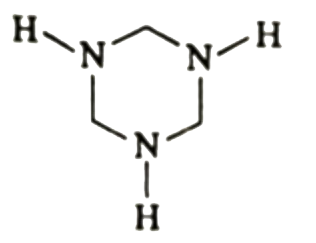Formaldehyde reacts with excess of ammonia to give
CH2=NH


Hexamethylenetetramine
The correct Answer is:D
To solve the question of what formaldehyde reacts with excess ammonia to give, we can follow these steps:
Step 1: Identify the Reactants
Formaldehyde (CH₂O) is the first reactant, and ammonia (NH₃) is the second reactant.
Step 2: Understand the Reaction
When formaldehyde reacts with ammonia, it can undergo a condensation reaction. In the presence of excess ammonia, formaldehyde can form a complex compound.
Step 3: Determine the Product
The reaction between formaldehyde and excess ammonia leads to the formation of hexamethylenetetramine (also known as urotropine). The chemical formula for hexamethylenetetramine is C₆H₁₂N₄.
Step 4: Write the Balanced Equation
The balanced chemical equation for the reaction is:
6CH2O+4NH3→C6H12N4+6H2O
Step 5: Conclusion
Thus, the product formed when formaldehyde reacts with excess ammonia is hexamethylenetetramine.
Final Answer
Formaldehyde reacts with excess ammonia to give hexamethylenetetramine.
---
Formaldehyde (CH₂O) is the first reactant, and ammonia (NH₃) is the second reactant.
When formaldehyde reacts with ammonia, it can undergo a condensation reaction. In the presence of excess ammonia, formaldehyde can form a complex compound.
The reaction between formaldehyde and excess ammonia leads to the formation of hexamethylenetetramine (also known as urotropine). The chemical formula for hexamethylenetetramine is C₆H₁₂N₄.
The balanced chemical equation for the reaction is:
6CH2O+4NH3→C6H12N4+6H2O
Thus, the product formed when formaldehyde reacts with excess ammonia is hexamethylenetetramine.
Formaldehyde reacts with excess ammonia to give hexamethylenetetramine.
Similar Questions
Knowledge Check
Chloromethane on treatment with excess of ammonia yields mainly
AN,N-dimethylmethanamine
 BN-methylmethanamine (CH3−NH−CH3)Cmethanamine (CH3NH2)Dmixture containing all these in equal proportion.
BN-methylmethanamine (CH3−NH−CH3)Cmethanamine (CH3NH2)Dmixture containing all these in equal proportion.Aldehydes other than formaldehyde react with Grignard reagent to give addition products which on hydrolysis give
Atertiary alcoholsBsecondary alcoholsCprimary alcoholsDcarboxylic acids.
Acetaldehyde reacts with Cl2 ( in excess) to give :
View SolutionWrite the balanced chemical equation for each of the following reactions:
Chlorine reacts with excess of ammonia.
View SolutionWrite the formula of the product formed when formaldehyde reacts with ammonia and name the product.
View SolutionEthylene glycol reacts with excess of PCl5 to give :
View SolutionA compound (C5H8) reacts with ammoniacal AgNO3 to give a white precipitate and reacts with excess of KMnO4 solution to give (CH3)2CH−COOH. The compound is
View SolutionAmmonia reacts with excess of chlorine to form
View Solution
